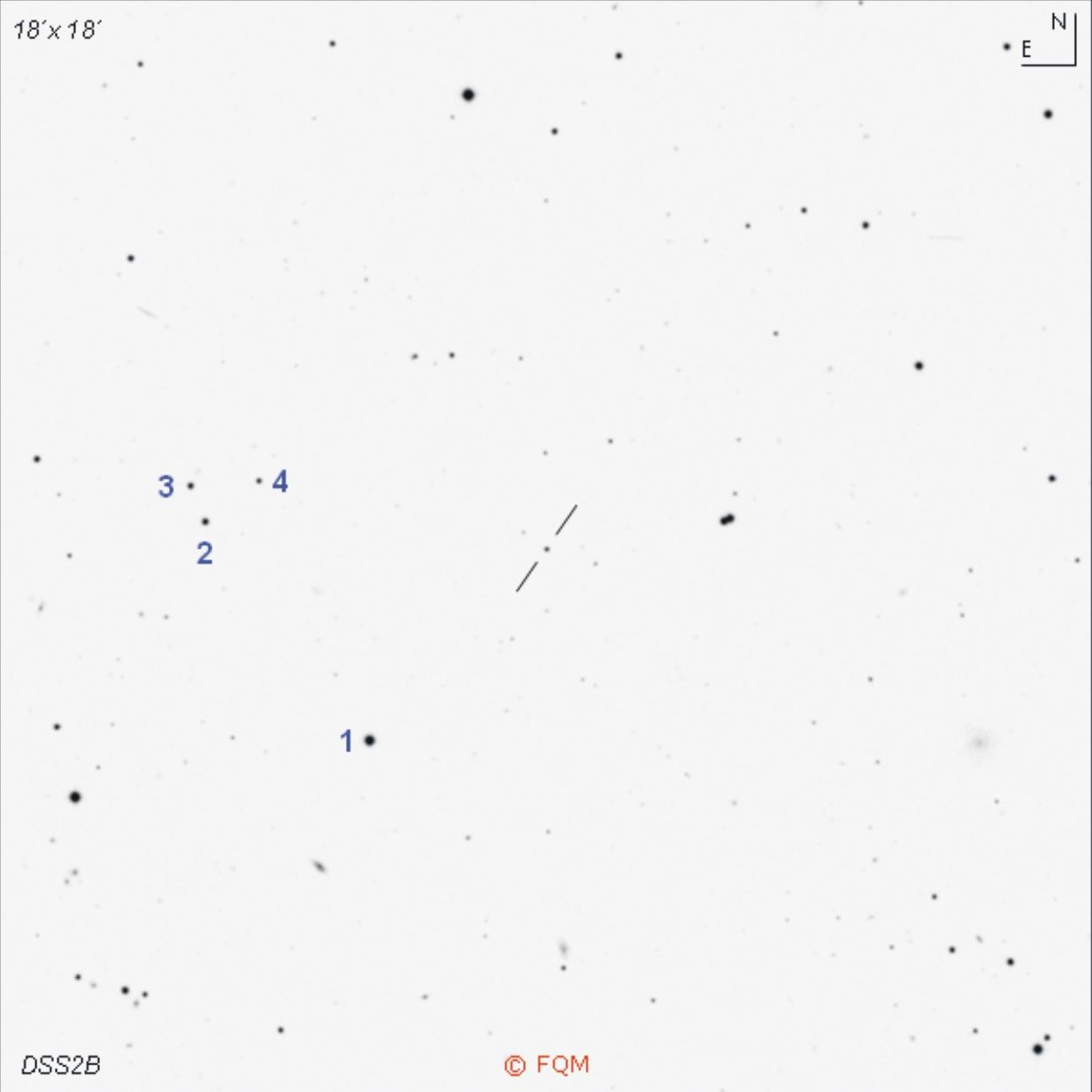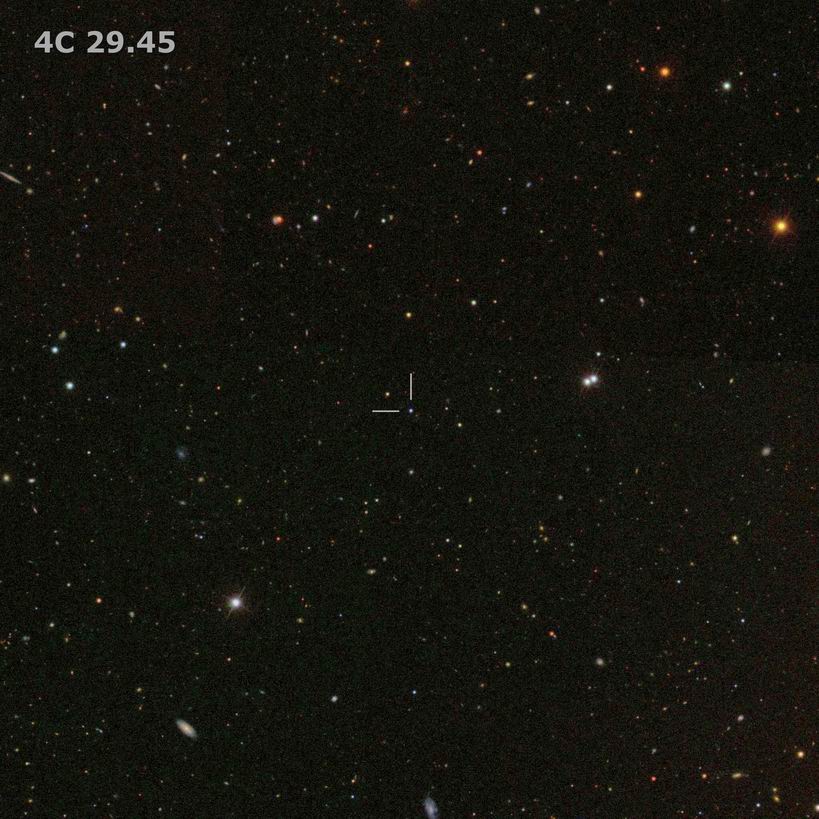
| Frankfurt Quasar Monitoring |
| 4C 29.45 |
| Cross-Identifications | TON 599, 4C +29.45, OM+295, CTD 77, CSO 166 PKS 1156+295, FBQS J1159+2914, 1156+295 2MASSi J1159317+291443, 2EG J1158+2906 LEDA 2820106, B2 1156+29, TXS 1156+295 87GB 115657.7+293133, RX J1159.5+2914 SDSS J115931.83+291443.8 |
| Equat. coordinates | RA 11 59 31.9 DE +29 14 45 (J2000) |
| Constellation | Ursa Major |
| Type | QSO |
| Redshift (2) | z=0.724 |
| Distance (2) (3) | 2510 Mpc |
| Total mag range (mv) (4) (5) | 12.8 - 18.5 |
| Catalog Magnitude (1) | 14.41 |
| Absolute Magnitude (1) | -28.6 MB |
| Light Travel-Time (2) | 6.260 × 109 yrs |

Comparison stars
| star | B | V | Rc |
| 1 | 14.01 (0.06) |
13.39 (0.05) |
13.01 (0.02) |
| 2 | 16.01 (0.06) |
15.38 (0.05) |
15.00 (0.02) |
| 3 | 16.44 (0.04) |
15.91 (0.04) |
15.54 (0.02) |
| 4 | 17.15 (0.05) |
16.60 (0.04) |
16.28 (0.02) |


| 4C
29.45 is a violently variable quasar in southern Ursa Major, close to
the
constellations Coma Berenices
and Leo. 4C
29.45 was discovered as a "blue stellar object" in the late 1950s by
mexican Tonantzintla Blue
Stellar Objects Survey (TON). In
the 1960s, this blue
stellar object
was identified as the optical
counterpart of the radio
source 4C 29.45, which was detected by the 4th Cambridge Radio Survey (4C). Since then, 4C:29.45 has been cataloged by several other radio surveys. In
addition, it was detected as a source
of
both X-ray and gamma emissions. 4C 29.45 displays extremely large and rapid flux variations at both radio and optical wavelengths, with variability time-scales varying from minutes to years - a typical OVV. 4C 29.45 is optically very active with a total range of nearly 6 magnitudes, showing large optical outbursts. Observations by the Frankfurt Quasar Monitoring programme have recorded minimum magnitudes down to about 18.5 mag. This is 0.4 magnitudes fainter than the data from the literature. Visual observers with telescopes of 8- to 10-inch of aperture may only observe this quasar during times of outburst. Large aperture telescopes improve the chance of catching this quasar in the eyepiece. 4C 29.45 is most suitable for CCD observers, as this quasar displays brightness variations from day to day. Due to its large distance of more than 6×109 light-years this quasar only shows up as a stellar object. CCD observers, as well as visual observers, shall use the comparison stars given above. Other photometric sequences were published by Wills et al. (1983), Smith et al. (1985), Gonzŕlez-Pérez et al. (2001), and the AAVSO. ____________
Starting our visual trip into the vicinity of 4C 29.45 we first move about 6° to the SE, where we take a look at the large naked eye open cluster Mel 111, also dubbed the "Coma Cluster", only about 280 light-years away. Turning 4.5° to the E we find the neighbouring galaxy group around NGC 4274. |
| Aldcroft, T.L, Bechtold, J., Elvis, M. 1994, ApJS, 93, 1; MgII Absorption in a Sample of 56 Steep-Spectrum Quasars. Brotherton, M.S. 1996, ApJS, 102, 1; The Profiles of H beta and [O III] lambda 5007 in Radio-loud Quasars. Burbidge, E.M. 1968, ApJ, 154, 109; Spectroscopic Observations of Twenty-Five Quasi-Stellar Objects. Craine, E.R. 1977; A Handbook of Quasistellar and BL Lacertae Objects; Parchart Publishing House, Tuscon. Gonzŕlez-Pérez, J.N., Kidger, M.R., et al. 2001, AJ, 122, 2055; Optical and Near-Infrared Calibration of AGN field stars: An All-Sky Network of faint stars calibrated on the Landolt System. Grauer, A.D. 1984, ApJ, 277, 77; Evidence for Rapid Optical Variations of the Quasistellar Radio Source 4C 29.45. Iriarte, B., Chavira, E. 1957, BOTT, 2, 3; Estrellas azules en el Casquete Galactico Norte. Karge, S.; Helle Quasare für 8- bis 10-Zoll Teleskope. Ein Beobachtungsführer zur visuellen Beobachtung von Quasaren und BL Lacertae Objekten; Frankfurt 2005. Katajainen, S., Takalo, L.O., et al. 2000, A&AS, 143, 357; Tuorla Quasar Monitoring. I. Observations of 1995-1997. Lynds, R., Wills, D. 1968, ApJ, 153, 23; Spectroscopic Observations of some suggested Quasi-Stellar Sources. Olsen, E.T. 1970, AJ, 75, 764; Optical Identification of Radio Sources Selected from the 4C Catalogue. Pilkington, J.D.H., Scott, P.F. 1965, Mem. Roy. Astron. Soc. 69, 183; A Survey of Radio Sources between Declinations 20° and 40°. Raiteri, C.M., Ghisellini, G., Villata, M., et al. 1998, A&AS, 127, 445; Optical Photometric Monitoring of Gamma-ray loud Blazars. II. Observations from November 1995 to June 1996. Raiteri, C.M., Villata, M., et al. 1998, A&AS, 130, 495; BVR Photometry of Comparison Stars in Selected Blazar Fields, II: Photometric Sequences for 9 Quasars. Schmidt, M. 1975, ApJ, 195, 253; Erratum: Optical Spectra and Redshifts of 4C Quasi-Stellar Radio Sources. Smith, P.S., Balonek, T.J., et al. 1985, AJ, 90, 1184; UBVRI Field Comparison Stars for Selected Active Quasars and BL Lacertae Objects. Steinicke, W.; Katalog heller Quasare und BL Lacertae Objekte; Umkirch 1998. Steinicke, W.; Beobachtungsliste für helle Quasare; Umkirch 1999. Véron-Cetty, M.-P., Véron, P. 2001, A&A 374, 92; A Catalogue of Quasars and Active Nuclei: 10th edition. Véron-Cetty, M.-P., Véron, P. 2003, A&A 412, 399; A Catalogue of Quasars and Active Nuclei: 11th edition. Véron-Cetty, M.-P., Véron, P. 2006, A&A 455, 776; A Catalogue of Quasars and Active Nuclei: 12th edition. Véron-Cetty, M.-P., Véron, P. 2010, A&A 518, 10; A Catalogue of Quasars and Active Nuclei: 13th edition. Villata, M., et al. 1997, A&AS, 121, 119; Optical Photometric Monitoring of Gamma-ray loud Blazars. I. Observations from November 1994 to November 1995. Webb, J.R., Smith, A.G., et al. 1988, AJ, 95, 374; Optical Observations of 22 Violently Variable Extragalactic Sources: 1968-1986. Wills, B.J., Pullock, J.T., et al. 1983, ApJ, 274, 62; The QSO 1156+295: A Multifrequency Study of Recent Activity. Wills, D. 1966, The Observatory 86, 245; 4C Radio Sources and Blue Stellar Objects. |
| home |